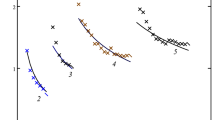Summary
A new perturbative procedure is analyzed numerically for four single bonded diatomic molecules. The starting model is the second-quantized self-consistent Heitler-London model. The unperturbed function is a four-determinant Bardeen-Cooper-Schrieffer function. The model Hamiltonian is the ordinary Hamiltonian plus linear and quadratic powers of a two-level number operator. Parameters which multiply the additional terms are chosen to enforce particle-number symmetry. Convergence of the perturbative series for the energy as a function of internuclear distance is reasonable: third-order corrections are about an order of magnitude smaller than second-order corrections; total corrections through third order are about two orders of magnitude smaller than first-order energies.
Similar content being viewed by others
References
Sorensen TE (1989) Bardeen-Cooper-Schrieffer-Lipkin-Nogami theory: A new method for electronic structure calculations with applications to potential energy curves for H2, LiH, FH, F2, and N2. PhD thesis, University of Wisconsin-Milwaukee
Sorensen TE, England WB, Silver DM (1989) J Phys B, 22:L539
Sorensen TE, England WB, Silver DM, Steinborn EO (1992) Quantum field theoretical methods in chemically bonded systems. II. Diagrammatic perturbation theory. Theor Chim Acta 84:1–19
Sorensen TE, England WB, Silver DM (1992) Quantum field theoretical methods in chemically bonded systems. III. BCSLN-HL(N) potential energy curves for the ground states of H2, LiH, FH and F2. Theor Chim Acta 84:21–35
Ring P, Schuck P (1980) The nuclear many-body problem. Springer-Verlag, Berlin
England WB (1982) J Phys Chem 86:1204
March NH, Young WH, Sampanthar S (1967) The many-body problem in quantum mechanics. Cambridge Univ Press, London
England WB (1983) Int J Quantum Chem 23:905
England WB (1983) Int J Quantum Chem Symp 17:357
Ahlrichs R (1975) Chem Phys Lett 34:570
England WB (1980) J Chem Phys 72:2108
Rowe DJ (1970) Nuclear collective motion: Models and theory. Methuen, London
Sorensen TE, England WB (1992) Quantum field theoretical methods in chemically bonded systems. V. Renormalization driven by the compensation principle and bubble diagrams. In preparation.
Pines D (1963) Elementary excitations in solids, Benjmain, NY
Tomašić ZA (1989) Open-shell many-body perturbation theory study of thea 3∏ and3Σ+ states of calcium oxide. PhD thesis, University of Wisconsin-Milwaukee
Author information
Authors and Affiliations
Additional information
This work was supported in part by the U.S. Department of the Navy, Space and Naval Warfare Systems Command under Contract N00039-89-C-0001, and in part by IBM RSP 3112. It was presented, in part, at the Midwest Theoretical Chemistry Conference, Indianapolis, Indiana, 1989, and at the Midwest Theoretical Chemistry Conference, Madison, Wisconsin, 1990.
Rights and permissions
About this article
Cite this article
Sorensen, T.E., England, W.B. & Silver, D.M. Quantum field theoretical methods in chemically bonded systems IV. Theoret. Chim. Acta 84, 37–53 (1992). https://doi.org/10.1007/BF01117402
Received:
Accepted:
Issue Date:
DOI: https://doi.org/10.1007/BF01117402




